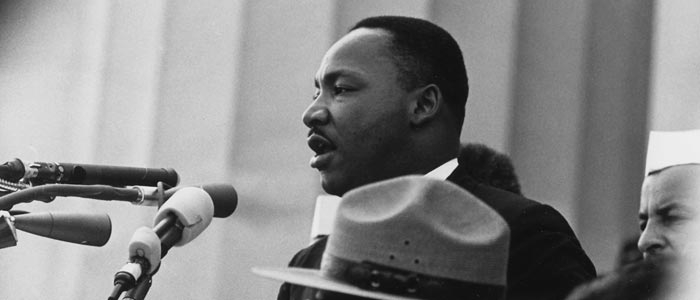
Civil Rights March on Washington, D.C. [Dr. Martin Luther King, Jr. speaking.] from NARA
August 28, 1963, in the shadow of the Lincoln Memorial, a man stood before hundreds of thousands of men and women. He spoke and they listened. He spoke and they cheered. He spoke and his words changed the world.
Martin Luther King, Jr.’s “I Have A Dream” speech is recognized as one of the most powerful deliveries in history. It wasn’t by chance his message took root in our hearts. It was crafted to do so.
Not only did King have a gift for public speaking, but he was also a powerful wordsmith. He understood how the nuances of language partnered with relevant, authoritative texts to create compelling arguments. His speech tugged at both the head and heart. He won men and women with both logic and emotion. While writing speeches is an art unto itself, all successful writing uses this same principle.
These are three of the techniques he used to do so:
He Created Common Footing
King’s speech is woven with patriotic and religious quotes. This allowed him to place the struggle for racial equality in a context which resonated with Americans, regardless of skin color.
He used phrases from Abraham Lincoln’s Emancipation Proclamation and the Declaration of Independence. He pulled lines from “My Country, ‘Tis of Thee” and the Bible.
He didn’t just talk about his struggle. He made it everyone’s. He did so by using history to create a common footing.
He Wrote For His Audience
In the 1960s, America was a predominantly Judeo-Christian country. At the time, the Bible was widely accepted as an authoritative text. King, a well-versed Baptist preacher, had an intimate knowledge of the Bible’s stories and lessons.
He harnessed this knowledge, drawing parallels between his struggles and those in the Bible. Calling himself an, “Exile in my own land,” he mirrored his fight for racial equality with the Jews’ struggle for freedom as told in Exodus. This created an image with which his audience was already familiar and comfortable.
He Used the Rule of Three
Endless repetition, the kind which goes on and on for no reason, will often put an audience to sleep. But, intentionally repeating an idea or a phrase is an entirely different story. This is especially true when you use the Rule of Three.
(The Rule of Three is recognized in multiple different forums, but always includes repeating the same word, phrase or theme three times.)
Don’t ask me why, but the human brain resonates with groupings of three. King repeats, “I have a dream,” three times. Each time he partners the phrase with images no person could justify not wanting for him or herself. This reinforcement hooked his audience and drove the point home.
No two forums are exactly alike. Speeches are different than novels, essays and letters home to mom. They are different than blog posts, web copy and company taglines. But, the most successful of each of these forums share the same principle as King’s – they appeal to the heart while speaking to the head.
We celebrate King today because he used language to transform our country’s idea of racial equality. Things aren’t perfect, but we’ve come a long way and his use of language is one of the reasons why.
Is every word you write from here on out going to change the face of history? Probably not. Yet, by using some of the same techniques as King, your words can be powerful statements.




